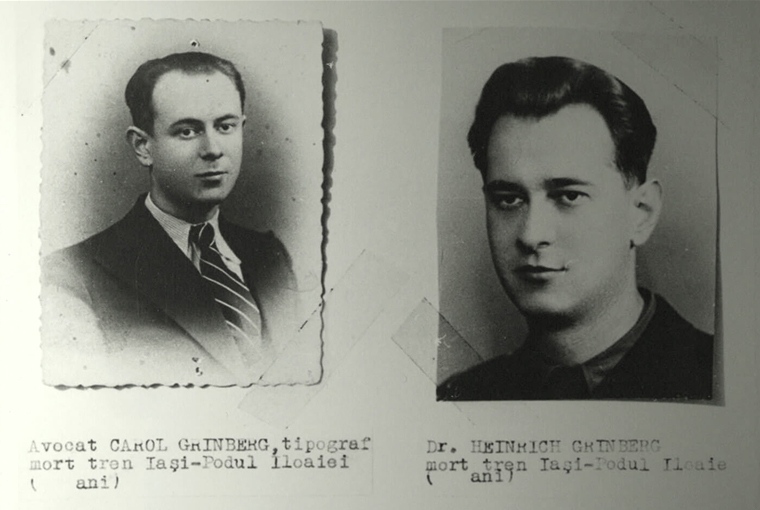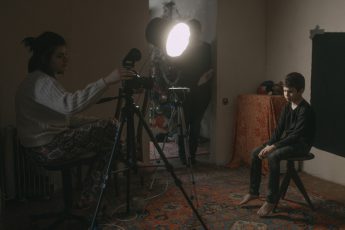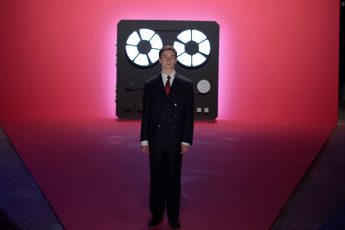Documentation and Imagination
The role of montage in Radu Jude’s The Exit of the Trains (Ieşirea trenurilor din gară, 2020)
Vol. 112 (February 2021) by Anastasia Eleftheriou
Radu Jude’s The Exit of the Trains, a collaboration with historian Adrian Cioflâncã, examines and questions how we can document and remember the atrocities of the Iași pogroms, which took place from June 29 to July 6, 1941 in the Romanian city of Iași and resulted in the murder of more than 13,000 Jewish people, representing about one third of the city’s Jewish population. The pogroms were executed by the Romanian army under the order of Marshal Ion Antonescu and mobilized the participation of the local population. The Exit of the Trains is based on archival footage, for the most part consisting of a three-hour slideshow of about two hundred portrait photographs depicting the victims of the pogroms. The slideshow is accompanied by over two hundred voiceovers of different collaborators, who recite texts from documents related to the massacres: witness accounts, diaries, testimonies from the post-war trials and interviews with survivors.1 The title of the film refers to piles of dead bodies that were torn out of the cattle cars. These death trains deported thousands of Jews from Iași out of the city, after which they would drive around the countryside for several days until the passengers died of asphyxiation, thirst, or hunger. Around twenty minutes of photographs of dead bodies, some of these depicting the dead scattered beside the train cars, conclude Jude’s film. This second part of the film showing the few surviving photographs of the actual atrocities is accompanied by total silence. Cioflâncã had compiled the material for The Exit of the Trains from various archives and institutions around the world over a period of ten years. According to an interview with Cineuropa, the collection was drawn from the archives of the United States Holocaust Memorial Museum, the Romanian National Archives, the Romanian Center for the Study of Jewish History, the National Council for the Study of State Police Archives, Yad Vashem, the Romanian Military Archives as well as other sources.2 The reconstruction of the personal narratives behind the photographs was helped by a social media campaign (#numenunumere [#namesnotnumbers]), via which Jude sought to make contact with survivors and their relatives in Iași.3
Radu Jude’s interest, not to say obsession with history, has been expressed through many of his recent films. Aferim (2015) and Scarred Hearts (2016) already deal with issues of racism and antisemitism in the nineteenth and early twentieth century. Uppercase Print (2020), like Jude’s short film The Marshal’s Two Executions (2018), focuses on the role that the media played in the construction and “recording” of history under Nicolae Ceausescu. All of these films marked a radical shift from his earlier work, which was closer in content and style to the films of the Romanian New Wave, dealing with issues of post-socialism as experienced in family life. With The Dead Nation (2017) and I Don’t Care if We Go Down in History as Barbarians (2018), the director started to explore themes of genocide and memory in Romania, a country that has only very recently started to deal with its responsibility in the assassination of Jewish communities during the Second World War. In Dead Nation and Barbarians, Jude elegantly avoids the trap of directly representing the Holocaust that has dogged artistic representations since Resnais’ Night and Fog (1956). Dead Nation was based on Emil Dorian’s published diaries, The Quality of Witness. Much like The Exit of the Trains, it reconstructs images from a photo collection by Costică Acsinte, who was working as a war photographer at the time and owned a photo studio in his hometown of Sloboozia. The five hundred or so pictures used in the film depict the everyday life of women, men and children, and cover the years of Dorian’s journal, 1938 to 1946. In Barbarians, the main character, Mariana (Ioana Iacob), is preparing a theater performance in Bucharest that restages the Odessa massacre, in which tens of thousands of Jews were killed in the course of three days, also under the direct order of Ion Antonescu. While Mariana is researching her reenactment, we glance at archival images of the atrocities in Odessa. (For example, in one scene, the viewer sees a photo of “the hanged in Odessa”.) Nevertheless, these archival images are only seen in passing, never made to fully occupy the screen. More than revealing the event itself, they allude to the composite nature of remembering it.4 In short, both of these films avoid cinematographic representations of the Holocaust through a stylistic recourse to text or theatre: the atrocities are either read, researched or rehearsed. The Exit of the Trains, then, is Jude’s first film that shows archival images of the Holocaust in a direct or unfiltered way. It is, to update Saul Friedländer, his first attempt at “unlimited” representation.5
Jude has noted that Dead Nation and Exit of the Trains are often “not considered cinema” because they “only consist of photographs.” Precisely to that point, however, both films use “montage as a construction device” in order to create cinema from material that “from a traditional point of view [is] not cinematic.”6 It is only through the editing process that these films become cinematographic. In his director’s statement to the film, he expands on this idea, quoting the French art historian Georges Didi-Huberman at length:7
Why a montage film with photographs and texts related to the Jassy pogrom of 1941? Because, as Georges Didi-Huberman shows, “Montage will precisely be one of the fundamental responses to this problem of the construction of historicity. As it has no simple orientation, […] the historian gives up telling ‘a story’, but, by doing so, he succeeds in showing that history cannot go without all the complexities of time, all the layers of archaeology, all the dottings of the destiny.
Didi-Huberman is, of course, at the forefront of the representability debates, having written a whole book to show that four photographs of Auschwitz taken in August 1944 (that are the basis for Son of Saul), are sufficient to reconstruct and represent the Holocaust, arguing against people like Claude Lanzmann who believe that the Holocaust is best remembered in forms where it is not visually reproduced.8 According to Didi-Huberman, on the other hand, we must say that Auschwitz, precisely because forgetting it was systematically inscribed into the event itself, “is only imaginable.” In that sense, Jude’s film is relevant to Hubermann’s concerns about the possibility and political responsibility of historical representation. By playing creatively with the pieces of history’s puzzle, Jude manages to effectively reconstruct the Iași Pogrom without needing to show it. This seems like a paradox: how can you show something without showing it? Didi-Hubermann, it seems—and this is where the above-mentioned quote comes into play—believes in a certain possible reconstruction of historicity, praising montage as a unique way of making that possible.
The Exit of the Trains tries to achieve this by showing photographic portraits while a voiceover—contemporary re-readings (among them Ioana Iacob) of hundreds of primary accounts—narrates or recounts the circumstances and proceedings of the atrocities that befell each subject in the photographs. Looking at the portraits and listening to the testimony triggers the imagination, pushing the viewer to mentally reconstruct a scene that is never finally represented on screen. To give one example, as the static portrait of a man named Iosif Aronovici hangs on the screen, the voiceover (a male voice, conceivably the testimony of his son) describes in detail how Aronovici was arrested and killed.9 On June 30, 1941, a constable known as Bocancea came to their house and forced the witness and his father to follow him to the station at gunpoint. They both tried to change the constable’s mind by showing him some documents the police had given them the previous day, but the constable claimed they were not valid. Aronovici, realizing that his wife’s pleas were in vain, decided to offer 50,000 lei to the constable. The officer replied that this amount of money was enough to spare the rest of the family, but that he would still take away Aronovici. The constable did not even allow him a bottle of water, and as they walked to the station the mother saw the constable beating Iosif in the face with a pistol. Some days later, the family heard, by way of railway employees, that Iosif Aronovici had been killed in the police station. His dead body was put aboard one of the death trains headed to Podu lloaiei.
The narration of this story is spoken over the single portrait of Aronovici. The image is in close-up, depicting the subject in a two-thirds view. Aronovici wears a suit, a white shirt and a tie. He is middle-aged, with thick hair, heavy eyebrows and a toothbrush mustache. His eyes appear to be looking at the camera. He does not smile, but very few of the subjects in the other photographs do either. (Smiling was not customary in portraits until the mass culture and snapshot photography of the early 1960s).10 There are some age-spots on the photo. It is hard to see this portrait in this way, however, as the mind is reconstructing an entirely different portrait: not that of the man, wearing a suit to have his picture taken, but that of his family, struggling to rescue themselves from the impending atrocities. Did they even have the possibility to say goodbye to their father? How much did they know about the killings, having likely witnessed the pogroms of the previous day? Would they have hoped for a reunion or were they aware of the death trains? And so it is that, throughout the first part of the film, entitled “statements and testimonies”, the Holocaust becomes imaginable, sometimes very vividly and always very cruelly, without ever being shown.
What role does montage play in this process of imagination? “Why a montage film?” Surely, the assemblage of the photographs defines Jude’s film. It is, however, only in relation to the spoken text that the film’s editing achieves its intention of drawing our attention to the question of representability, the question of making the invisible visible. It is also certainly true that montage has “no simple orientation”, as Didi-Hubermann claims in the quote above. Indeed, some editors work in an open-ended way, which means that they construct a film piece by piece and let themselves be led, without preconceptions, by the images into new paths. In a text for Vacarme, editor Claire Atherton explains:11
When people ask me about the way I work in editing, I always insist on the fact that one has to discover by doing. It’s important to know what the point of departure is but we should take the risk of not knowing where we’re going. I’m not expecting a film to describe reality to me, which is what people expect documentaries to do, nor do I expect it to tell a story, which is what people expect from fiction. I’m trying to create a space in which spectators will create their own links to the film, they’ll feel it, they’ll perceive and experience it in their own unique way. I want films to provoke thinking and questioning of one’s perception of themselves and of the world.
This type of editing obviously privileges freedom of interpretation as opposed to didacticism or control. In the case of The Exit of the Trains, whose editing scheme is largely based on repetition of form, it would be interesting to know how much the process of montage really dictated the film’s evolution and direction. In any event, however, montage in Jude’s film is not only a tool that serves to weave information together, to document, but an invitation for the spectator to do the work of constructing the story. Both Didi-Huberman and Atherton insist on this power of montage to resist telling a story, to invite the spectators to become active in the process of memory and historical reconstruction. Montage may not be the only response to the fundamental problem of the limits of representation. The Jewish Museum in Berlin has expressed the same idea architecturally in its “voids,” the empty spaces that cut through the building from the basement to the roof. The voids break up the story, the documentation, that is provided by the contents of the exhibition, leaving room for the visitors to imagine the unimaginable, and experience the immensity of history’s lacunae.
So why, then, end the film with the archival images of the pogroms? Does this not flout Didi-Huberman’s sophisticated solution to the representability problem? Jude himself said that “[…] I didn’t want these photographs to be contemplated like works of art. […] So I make them as short as possible to only give the information, which is followed by a cut to another photograph.”12 The concern for seeing war photographs as works of art is, of course, another story, one most prominently raised by Susan Sontag, who believed that a passivity was inevitable when looking at war photographs. In her 1977 essay “On Photography”, she even went so far as to compare images of violence with tourism.13 Again, Jude appears to use montage to solve this problem. The quick cuts are supposed to keep the images from being consumed, from making a spectacle out of the event. Much like the discord between the portrait photographs and the voiceover, the careful rhythm is used to keep the spectator from becoming a passive consumer of history’s darkest hours. Nevertheless, this second part is also edited within the film as a whole. The atrocious photographs thus also connect the subjective imagination, and the personalized experiences the viewer has amassed in the first part of the film, with the objective reality and the depersonalized or collective trauma of the event itself. Creating a montage that juxtaposes these extremes may also show that the latter cannot stand in for the former, and that an insurmountable distance remains, even when both approaches are reconciled.
In Romania, these questions of representation may come prematurely, as the country has only recently started to publicly acknowledge its participation in the destruction of the European Jews.14 It may, therefore, still be the larger task to inform the public about what happened as opposed to reflecting on how to represent it. The discourse on the latter, the representation of the Holocaust (Jude quoting Didi-Hubermann in a director’s statement for the film’s premiere at the Berlinale), seems to be inspired by and addressed to a Western audience. The discourse on the former, documenting and informing the public about what happened (notably collecting the material—the archival work of Adrian Cioflâncă), seems to be more directly pertinent for local audiences. “History is used and abused all the time in order to create ideas for the present, to create identities, narratives, ideologies,” Jude says, reflecting on his motivation for making historical films.15 Questioning history implies questioning national identity. Perhaps Jude and Cioflâncã also felt that the questioning of their own national history could rattle the foundations of today’s nationalist, racist, xenophobic, and sexist Europe, in which anti-Semitism and Islamophobia are pervasive.
References
- 1.165 witnesses, mostly survivors of the pogrom, were called to the stand in trials that took place in Cluj during the Romanian People’s Tribunals in 1946, in which 23 people were sentenced, among them Ion Antonescu. The re-assemblage of these documents is the result of a long and thorough research effort conducted by the co-author of the film, Adrian Cioflâncã.
- 2.Cioflâncă, A. (2020). Interviewed by Stefan Dobroiu for Cineuropa, 27 February. Available at: https://cineuropa.org/en/interview/386031/ [Accessed on February 28 2021]. A complete list of sources can be seen in the film’s closing credits.
- 3.Ibid.
- 4.See Popa, D. (2019). “Hopeless Didacticism: Archival Sources and Spectatorial Address in `I Do Not Care If We Go Down in History as Barbarians.’’’ Law, Culture and the Humanities.
- 5.Friedländer, S. ed., 1992. Probing the Limits of Representation: Nazism and the final Solution (p. 37). Cambridge, MA: Harvard University Press.
- 6.Jude, R. (2020). Interviewed by Hugo Emmerzael for Senses of Cinema, April 2020. Accessible at : https://www.sensesofcinema.com/2020/conversations-with-filmmakers-across-the-globe/radu-jude/ [Accessed on February 28 2021].
- 7.Didi-Huberman’s original quote can be found in Didi-Huberman, G. (2004). “‘L’image brûle’”. Artpress 25, pp. 68-73.
- 8.Didi-Huberman, Georges. Images malgré tout (Paris: Minuit), 2003. For a discussion of these debates with regards to Son of Saul, see Bosch, Santos P. (2016). “Soft Porn for Refined People: Son of Saul within the History of Holocaust Representation.’’ East European Film Bulletin, Vol. 69. Retrieved from https://eefb.org/perspectives/son-of-saul-within-the-history-of-holocaust-representation/ [Accessed on February 28 2021].
- 9.The name of each person depicted in the photograph is stated on the left of the screen by the filmmaker.
- 10.Kotchemidova, Christina. Why we say “cheese’’: Producing the smile in snapshot photography. Critical Studies in Media Communication 22.1 (2005): 2-25.
- 11.Atherton, C. (2018). “L’art du montage’’, Vacarme, 82/ Cahier. Retrieved from : https://vacarme.org/article3108.html [Accessed on February 28 2021].
- 12.Jude, R (2020), ibid.
- 13.Sontag, S. (1977), On photography. New York: Farrar, Straus and Giroux. In her later work, Sontag, S. (2003). Regarding the pain of others. New York: Farrar, Straus and Giroux, she somewhat modified her claims, but the initial skepticism with regards to the moral value of such images remained.
- 14.Following the Wiesel Report of 2004, Romania has slowly started to deal with its past. See “The Report of the International Commission on the Holocaust in Romania”, Bucharest, 11 November 2004, available online at http://www.yadvashem.org/about–yad/what–new/index– whats–newreport.html [Accessed on February 28 2021].
- 15.Jude, R. (2020), ibid.




Leave a Comment